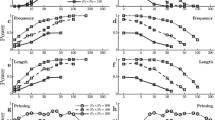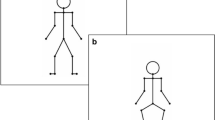Abstract
An experiment was conducted to determine whether multi-frequency continuous bimanual circling movements of varying difficulty (1:2. 2:3, 3:4, and 4:5) could be effectively performed following relatively little practice when on-line continuous relative velocity feedback is provided. The between-subjects results indicate extremely effective bimanual multi-frequency performance for all coordination patterns with relatively stable and continuous movements of both limbs. The findings suggest that the previous performance effects using Lissajous feedback with reciprocal movement can be extended to circling movements using on-line relative velocity feedback. Contrary to the long-held position that these coordination patterns result in increasing difficulty, we failed to find systematic relative velocity error, variability, or bias differences between the participants performing the various multi-frequency coordination patterns. Indeed, coordination error, variability, and biases were remarkably low for each of the tasks. The results clearly indicate the ease with which participants are able to produce bimanual coordination patterns typically considered difficult if not impossible when salient visual information is provided that allows the participants to detect and correct their coordination errors.



Similar content being viewed by others
Notes
Comparisons across limbs of the variability of the cycle duration means should be viewed with caution because in all subjects and all conditions the left limb was moving slower than the right limb to achieve the desired frequencies. Thus, if the variability results were expressed in relation to cycle duration (coefficient of variation), the differences could disappear or even reverse.
References
Amazeen EL, DaSilva F, Amazeen PG (2008) Visual-spatial and anatomical constraints interact in a bimanual coordination task with transformed visual feedback. Exp Brain Res 191:12–24
Arnold VI (1983) Geometrical methods in the theory of ordinary differential equations. Springer, NY
Atchy-Dalama P, Peper CE, Zanone PG, Beek PJ (2005) Movement-related sensory feedback mediates the learning of a new bimanual relative phase pattern. J Mot Behav 37:186–196
Bingham GP (2004a) A perceptually driven dynamical model of bimanual rhythmic movement (and phase perception). Ecol Psychol 16:45–53
Bingham GP (2004b) Another timing variable composted of state variables: phase perception and phase driven oscillators. In: Hecht H, Savelsbergh GIP (eds) Advances in psychology time to contact. Elsevier, Amsterdam, pp 421–442
Bingham GP, Schmidt RC, Zaal FTJM (1999) Visual perception of relative phasing in human limb movements. Percept Psychophys 61:246–258
Boyle JB, Shea CH (2011) Arm and wrist control: extended practice fitts’ task. J Sport Exerc Psych 33:S100
Byblow WD, Goodman D (1994) Performance asymmetries in multifrequency coordination. Hum Move Sci 13:147–174
Carson RG, Kelso JAS (2004) Governing coordination: behavioural principles and neural correlates. Exp Brain Res 154:267–274
Debaere F, Swinnen SP, Beatse E, Sunaert S, Van Hecke P, Duysens J (2001) Brain areas involved in interlimb coordination: a distributed network. Neuroimage 14:947–958
Debaere F, Wenderoth N, Sunaert S, Van Hecke P, Swinnen SP (2003) Internal vs external generation of movements: differential neural pathways involved in bimanual coordination performed in the presence or absence of augmented visual feedback. Neuroimage 19:764–776
Debaere F, Wenderoth N, Sunaert S, Van Hecke P, Swinnen SP (2004) Changes in brain activation during the acquisition of a new bimanual coordination task. Neuropsychologia 42:855–867
deGuzman GC, Kelso JAS (1991) Multifrequency behavioral patterns and the phase attractive circle map. Biol Cybern 64:485–495
Deutsch D (1983) The generation of two isochronous sequences in parallel. Percept Psychophys 34:331–337
Fernandez L, Bootsma RJ (2008) Non-linear gaining in precision aiming: making Fitts’ task a bit easier. Acta Psychol 129:217–227
Fraisse P (1946) Contribution a etude du rythme en tant que forme temporelle. J de Psychologie Normale et Pathologique 39:283–304
Haken H, Kelso JAS, Bunz H (1985) A theoretical model of phase transitions in human hand movements. Biol Cybern 51:347–356
Haken H, Peper CE, Beek PJ, Daffertshofer A (1996) A model for phase transitions in human hand movements during multifrequency tapping. Phys D Nonlinear Phenom 90:179–196
Hurley SR, Lee TD (2006) The influence of augmented feedback and prior learning on the acquisition of a new bimanual coordination pattern. Hum Move Sci 25:339–348
Kelso JAS (1995) Dynamic patterns: the self-organization of brain and behavior. MIT Press, Cambridge
Kelso JAS, deGuzman GC (1988) Order in time: how cooperation between the hands informs the design of the brain. In: Haken H (ed) Neural and synergetic computers. Springer, Berlin, pp 180–196
Kovacs AJ, Shea CH (2010) Amplitude differences in bimanual coordination. Exp Brain Res 202:519–525
Kovacs AJ, Buchanan JJ, Shea CH (2008) Perceptual influences on Fitt’s law. Exp Brain Res 190:99–103
Kovacs AJ, Buchanan JJ, Shea CH (2009a) Bimanual 1:1 with 90° continuous phase: difficult or easy? Exp Brain Res 193:129–136
Kovacs AJ, Buchanan JJ, Shea CH (2009b) Using scanning trials to assess intrinsic coordination dynamics. Neurosci Lett 455:162–167
Kovacs AJ, Buchanan JJ, Shea CH (2010a) Impossible is nothing: 5:3 and 4:3 multi-frequency bimanual coordination. Exp Brain Res 201:249–259
Kovacs AJ, Buchanan JJ, Shea CH (2010b) Perceptual and attentional influences on continuous 2:1 and 3:2 multi-frequency bimanual coordination. J Exp Psychol Hum Percept Perform 36:936–954
Lee TD, Swinnen SP, Verschueren S (1995) Relative phase alterations during bimanual skill acquisition. J Mot Behav 27:263–274
Mechsner F, Kerzel D, Knoblich G, Prinz W (2001) Perceptual basis of bimanual coordination. Nature 414:69–73
Peper CE, Beek PJ, van Wieringen PCW (1995a) Coupling strength in tapping a 2:3 polyrhythm. Hum Move Sci 14:217–245
Peper CE, Beek PJ, van Wieringen PCW (1995b) Multifrequency coordination in bimanual tapping: asymmetrical coupling and signs of supercriticality. J Exp Psychol Hum Percept Perform 21:1117–1138
Peper CE, Beek PJ, van Wieringen PCW (1995c) Frequency-induced phase-transitions in bimanual tapping. Biol Cybern 73:301–309
Ridderikhoff A, Peper CE, Beek PJ (2005) Unraveling interlimb interactions underlying bimanual coordination. J Neurophysiol 94:3112–3125
Riek S, Woolley D (2005) Hierachical organization of neuro-anatomical constraints in interlimb coordination. Hum Move Sci 24:798–814
Riek S, Carson RG, Byblow WD (1992) Spatial and muscular dependencies in bimanual coordination. Hum Move Sci 23:251–265
Ryu Y, Buchanan JJ (2009) Learning an environment-actor skill: visuomotor transformation and coherency of perceptual structure. Exp Brain Res 196:279–293
Schöner G, Haken H, Kelso JAS (1986) A stochastic theory of phase transitions in human hand movement. Biol Cybern 53:247–257
Schöner G, Kelso JAS (1988) Dynamic pattern generation in behavioral and neural systems. Science 239:1513–1520
Shea CH, Boyle J (2011) Bimanual coordination: evaluating feedback displays. J Sport Exerc Psychol 33:S112
Sternad D, Turvey MT, Saltzman EL (1999a) Dynamics of 1:2 coordination: generalizing relative phase to n:m rhythms. J Mot Behav 31:207–223
Sternad D, Turvey MT, Saltzman EL (1999b) Dynamics of 1:2 coordination: sources of symmetry breaking. J Mot Behav 31:224–235
Summers JJ, Todd JA, Kim YH (1993) The influence of perceptual and motor factors on bimanual coordination in polyrhythmic tapping task. Psychol Res 55:107–125
Summers JJ, Davis AS, Byblow WD (2002) The acquisition of bimanual coordination is mediated by anisotropic coupling between the hands. Hum Move Sci 21:699–721
Swinnen SP (2002) Intermanual coordination: from behavioral principles to neural-networks. Nat Rev Neurosci 3:350–361
Swinnen SP, Wenderoth N (2004) Two hands, one brain: cognitive neuroscience of bimanual skill. Trends Cogn Sci 8:18–25
Swinnen SP, Dounskaia N, Verschueren S, Serrien DJ, Daelman A (1995) Relative phase destabilization during interlimb coordination: the disruptive role of kinesthetic afferences induced by passive movements. Exp Brain Res 3:439–454
Swinnen SP, Dounskaia N, Walter CB, Serrien DJ (1997a) Preferred and induced coordination modes during the acquisition of bimanual movements with a 2:1 frequency ratio. J Exp Psychol Hum Percept Perform 23:1087–1110
Swinnen SP, Lee TD, Verschueren S, Serrien DJ, Bogaerts DJ (1997b) Interlimb coordination: learning and transfer under different feedback conditions. Hum Move Sci 16:749–785
Swinnen SP, Verchueren MP, Bogaerts H, Dounskaia N, Lee TD, Stelmach GE, Serrien DJ (1998) Age related deficits in motor learning and differences in feedback processing during the production of a bimanual coordination pattern. Cogn Neuropsychol 15:439–466
Tomatsu S, Ohtsuki T (2005) The effect of visual transformation on bimanual circling movement. Exp Brain Res 166:277–286
Treffner PJ, Turvey MT (1993) Resonance constraints on rhythmic movement. J Exp Psychol Hum Percept Perform 19:339–363
Tuller B, Kelso JAS (1989) Environmentally-specific patterns of movement coordination in normal and split brain subjects. Exp Brain Res 75:306–316
Wilson AD, Collins DR, Bingham GP (2005a) Perceptual coupling in rhythmic movement coordination: stable perception leads to stable action. Exp Brain Res 164:517–528
Wilson AD, Collins DR, Bingham GP (2005b) Human movement coordination implicates relative direction as the information for relative phase. Exp Brain Res 165:51–361
Wilson AS, Snapp-Childs W, Coats R, Bingham GP (2010) Learning a coordinated rhythmic movement with task-appropriate coordination feedback. Exp Brain Res 205:513–520
Yamanishi J, Kawato M, Suzuki R (1980) Two coupled oscillators as a model for the coordinated finger tapping by both hands. Biol Cybern 37:219–225
Zaal FTJM, Bingham GP, Schmidt RC (2000) Visual perception of mean relative phase and phase variability. J Exp Psychol Hum Percept Perform 26:1209–1220
Zanone PG, Kelso JAS (1992) Evolution of behavioral attractors with learning: nonequilibrium phase-transitions. J Exp Psychol Hum Percept Perform 18:403–421
Author information
Authors and Affiliations
Corresponding author
Rights and permissions
About this article
Cite this article
Boyles, J., Panzer, S. & Shea, C.H. Increasingly complex bimanual multi-frequency coordination patterns are equally easy to perform with on-line relative velocity feedback. Exp Brain Res 216, 515–525 (2012). https://doi.org/10.1007/s00221-011-2955-x
Received:
Accepted:
Published:
Issue Date:
DOI: https://doi.org/10.1007/s00221-011-2955-x




